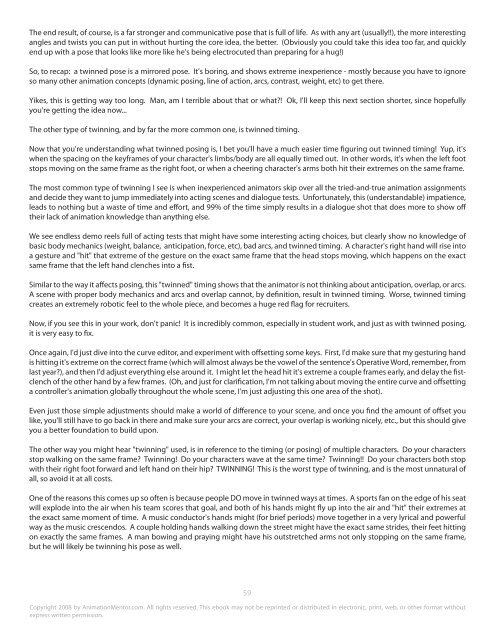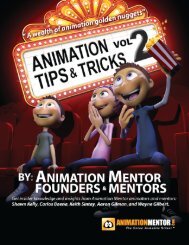The end result, of course, is a far stronger and communicative pose that is full of life. As with any art (usually!!), the more interestingangles and twists you can put in without hurting the core idea, the better. (Obviously you could take this idea too far, and quicklyend up with a pose that looks like more like he's being electrocuted than preparing for a hug!)So, to recap: a twinned pose is a mirrored pose. It's boring, and shows extreme inexperience - mostly because you have to ignoreso many other animation concepts (dynamic posing, line of action, arcs, contrast, weight, etc) to get there.Yikes, this is getting way too long. Man, am I terrible about that or what?! Ok, I'll keep this next section shorter, since hopefullyyou're getting the idea now...The other type of twinning, and by far the more common one, is twinned timing.Now that you're understanding what twinned posing is, I bet you'll have a much easier time figuring out twinned timing! Yup, it'swhen the spacing on the keyframes of your character's limbs/body are all equally timed out. In other words, it's when the left footstops moving on the same frame as the right foot, or when a cheering character's arms both hit their extremes on the same frame.The most common type of twinning I see is when inexperienced animators skip over all the tried-and-true animation assignmentsand decide they want to jump immediately into acting scenes and dialogue tests. Unfortunately, this (understandable) impatience,leads to nothing but a waste of time and effort, and 99% of the time simply results in a dialogue shot that does more to show offtheir lack of animation knowledge than anything else.We see endless demo reels full of acting tests that might have some interesting acting choices, but clearly show no knowledge ofbasic body mechanics (weight, balance, anticipation, force, etc), bad arcs, and twinned timing. A character's right hand will rise intoa gesture and "hit" that extreme of the gesture on the exact same frame that the head stops moving, which happens on the exactsame frame that the left hand clenches into a fist.Similar to the way it affects posing, this "twinned" timing shows that the animator is not thinking about anticipation, overlap, or arcs.A scene with proper body mechanics and arcs and overlap cannot, by definition, result in twinned timing. Worse, twinned timingcreates an extremely robotic feel to the whole piece, and becomes a huge red flag for recruiters.Now, if you see this in your work, don't panic! It is incredibly common, especially in student work, and just as with twinned posing,it is very easy to fix.Once again, I'd just dive into the curve editor, and experiment with offsetting some keys. First, I'd make sure that my gesturing handis hitting it's extreme on the correct frame (which will almost always be the vowel of the sentence's Operative Word, remember, fromlast year?), and then I'd adjust everything else around it. I might let the head hit it's extreme a couple frames early, and delay the fistclenchof the other hand by a few frames. (Oh, and just for clarification, I'm not talking about moving the entire curve and offsettinga controller's animation globally throughout the whole scene, I'm just adjusting this one area of the shot).Even just those simple adjustments should make a world of difference to your scene, and once you find the amount of offset youlike, you'll still have to go back in there and make sure your arcs are correct, your overlap is working nicely, etc., but this should giveyou a better foundation to build upon.The other way you might hear "twinning" used, is in reference to the timing (or posing) of multiple characters. Do your charactersstop walking on the same frame? Twinning! Do your characters wave at the same time? Twinning!! Do your characters both stopwith their right foot forward and left hand on their hip? TWINNING! This is the worst type of twinning, and is the most unnatural ofall, so avoid it at all costs.One of the reasons this comes up so often is because people DO move in twinned ways at times. A sports fan on the edge of his seatwill explode into the air when his team scores that goal, and both of his hands might fly up into the air and "hit" their extremes atthe exact same moment of time. A music conductor's hands might (for brief periods) move together in a very lyrical and powerfulway as the music crescendos. A couple holding hands walking down the street might have the exact same strides, their feet hittingon exactly the same frames. A man bowing and praying might have his outstretched arms not only stopping on the same frame,but he will likely be twinning his pose as well.59Copyright 2008 by <strong>Animation</strong><strong>Mentor</strong>.com. All rights reserved. This ebook may not be reprinted or distributed in electronic, print, web, or other format withoutexpress written permission.
Well, guess what? Those are all perfectly valid times to consciously decide to USE twinning in your posing and timing in order to bestsell the ideas of your shot. Having that praying man posed with one arm stretched out to the side will simply not look like a praying/bowing man. Letting that sports-fan's hands explode up into the air at the same time might feel pretty powerful, depending, asalways, on the style of animation your piece requires. (Realistic animation, in my opinion, should rarely, if ever, have any twinningat all, and in the sports-fan example, I would still off-set his hands by a frame to make it feel more organic. The more cartoony andexaggerated the style of your project is, the more you can safely twin WHEN YOU HAVE A REASON to do so).The couple walking with twinned footsteps has a lot of potential to look like bad animation cycles, but if you're careful in constructingit, you might be able to use the idea of twinned strides to show just how in love they are! They're so in love that when they holdhands, they share the same stride. Think it sounds crazy? Go sit on a bench for a while at a shopping mall and watch the coupleswander by - I guarantee you'll see more than a few twinning like crazy. The majority of the time, of course, you'll want to offset thesesteps by a frame or two in your animation, in order to have a nice organic feeling of life, but I do think a talented animator couldpotentially use this idea to emphasize the connection the characters share.The music conductor is a most perfect example, and we've all seen how nicely it worked out for Mickey Mouse in The Sorcerer'sApprentice. It was a big moment of realization for me, after Bobby, Carlos, and I had finally figured out the evils of twinning,committed ourselves to a twin-free life of animating, and then realizing that our heroes twinned Mickey Mouse like crazy in Fantasia!I think it was the first time I learned the invaluable lesson that there is an exception to every rule, and that the masters can breakthose rules when they have a reason to do so.For me, the best use of conscious twinning is to create a contrast between your "contrasted" posing and timing and a specificmoment where you want to really emphasize an idea or sell a joke. For example, you could have some nicely overlapping animation,fun dynamic ("contrasted") poses and timing of your character sneaking through an alley, and then the character hears somethingand zips into a shadow where he stands bolt upright, eyes wide in fear. This "twinned" pose might really sell your idea of "fear," andif you are working in a more cartoony, style you could twin the timing as well.Overall, though? Overall, you'll want to avoid twinning like the plague 99% of the time.Hopefully that answered your questions! If you have any other suggestions or topic requests, be sure to email me - I respond toeveryone, and am genuinely interested in hearing your thoughts.And as always, keep animating, and have FUN!-Shawn :)60Copyright 2008 by <strong>Animation</strong><strong>Mentor</strong>.com. All rights reserved. This ebook may not be reprinted or distributed in electronic, print, web, or other format withoutexpress written permission.
- Page 2 and 3:
Animation Tips & TricksBY: Shawn Ke
- Page 4 and 5:
INTRODUCTIONWelcome to the First Ed
- Page 6 and 7:
FOUNDERS BIOSBobby BeckBobby was an
- Page 8 and 9:
TESTIMONIALS“Three things come to
- Page 10 and 11:
PLANNINGBecause this is the first a
- Page 12 and 13:
REFERENCE MATERIALSWe've been talki
- Page 14 and 15:
THUMBNAILSWelcome back!This month w
- Page 16 and 17:
BLINKS HAVE MEANINGTip 1: Blinks Ha
- Page 18 and 19: Then a thought occurs to him: “is
- Page 20 and 21: has his shovel in hand. His eyes ar
- Page 22 and 23: THE FACEHey there animators! Welcom
- Page 24 and 25: OPERATIVE WORDSHello Animators!Welc
- Page 26 and 27: So, to make a long story short - ch
- Page 28 and 29: Well, for one thing, you want to sp
- Page 30 and 31: KEEP SECONDARY CHARACTERS SECONDARY
- Page 32 and 33: might glance at him to gauge his re
- Page 34 and 35: ACTINGHello Animators!Welcome back!
- Page 36 and 37: If you ignore the principles of act
- Page 38 and 39: Anyway, if the whole point of exagg
- Page 40 and 41: FORGET ABOUT THE LEGSHello animator
- Page 42 and 43: TRACK YOUR ARCSOkay, before I get s
- Page 44 and 45: it...Anyway, the hips move in a clo
- Page 46 and 47: TRACK YOUR ARCS - PART IIWell, gues
- Page 48 and 49: "Let's say my character is going to
- Page 50 and 51: But what's a love story without fir
- Page 52 and 53: cycle (say, a blink, or one hand ha
- Page 54 and 55: Step...Step...Punch. I had a big pr
- Page 56 and 57: after it. Once you choose your mome
- Page 58 and 59: incredibly easy to get so caught up
- Page 60 and 61: that's a toughie, but maybe you can
- Page 62 and 63: That's 40 years of inspiration. 40
- Page 64 and 65: TWINNINGHello!Last month, we were s
- Page 66 and 67: more organic, and far more interest
- Page 70 and 71: BLACK OUT YOUR CHARACTEROk, so it's
- Page 72 and 73: performance (particularly the eye a
- Page 74 and 75: RISE ABOVE THE SNOBBERYOkay, here's
- Page 76 and 77: Animation students live and work in
- Page 78 and 79: MOVING FROM TRANFORMERS TO CARTOONS
- Page 80 and 81: stylistically. Too fast here, dead
- Page 82 and 83: HOW TO IMPRESS RECRUITERSHello ther
- Page 84 and 85: ecruiter has no idea of your true a
- Page 86 and 87: 23TIPREVERSALSWell hello there!Last
- Page 88 and 89: From #1 to #2, all you really need
- Page 90 and 91: else we can decide that no, we don'
- Page 92 and 93: IT AIN’T OVER TILL THE CHARACTERS
- Page 94 and 95: project where the deadlines are too
- Page 96 and 97: then. The first one will be next mo
- Page 98 and 99: The computer will help you try to s








